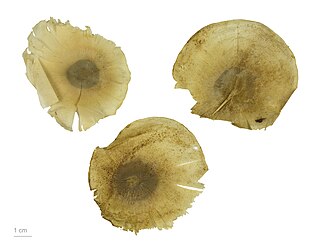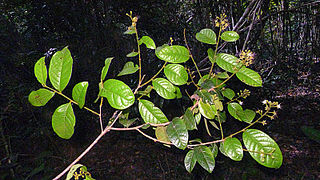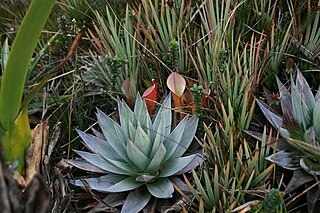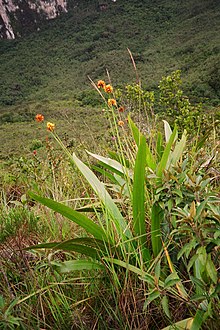
The Guiana Shield is one of the three cratons of the South American Plate. It is a 1.7 billion-year-old Precambrian geological formation in northeast South America that forms a portion of the northern coast. The higher elevations on the shield are called the Guiana Highlands, which is where the table-like mountains called tepuis are found. The Guiana Highlands are also the source of some of the world's most well-known waterfalls such as Angel Falls, Kaieteur Falls and Kuquenan Falls.

Mandevilla is a genus of tropical and subtropical flowering vines belonging to the family Apocynaceae. It was first described as a genus in 1840. A common name is rocktrumpet.
Micrandra is a plant genus of the family Euphorbiaceae first described in 1854. It is native to South America.

Mabea is a plant genus of the family Euphorbiaceae first described in 1775. It is native to Central and South America as well as Mexico and Trinidad.

Abolboda is a genus of flowering plants, traditionally and nowadays assigned to family Xyridaceae. It is native to South America and to the island of Trinidad, generally on marshy savanna.

The Guayana Region is an administrative region of eastern Venezuela.

Couratari is a genus of trees in the family Lecythidaceae, first described as a genus in 1775. They are native to tropical South America and Central America.

Aspidosperma is a genus of flowering plant in the family Apocynaceae, first described as a genus in 1824. It is native to South America, Central America, southern Mexico, and the West Indies.

Lindmania is a genus of plants in the family Bromeliaceae. It is one of two genera in the subfamily Lindmanioideae, and contains 39 species. All but one of the known species are native to Venezuela, a few occurring in neighboring Guyana and northern Brazil).

Lecythis is a genus of woody plant in the Lecythidaceae family first described as a genus in 1758. It is native to Central America and South America.

Micropholis is group of trees in the family Sapotaceae, described as a genus in 1891.

Hirtella is a genus of 110 species of woody trees in family Chrysobalanaceae. It was first described as a genus by Linnaeus in 1753. Hirtella naturally occurs in tropical forests throughout Latin America, the West Indies, southeast Africa, and Madagascar. The flowers are mainly pollinated by butterflies.

Couepia is a genus of flowering plants in the family Chrysobalanaceae described as a genus in 1775.

The natural range of the carnivorous plant genus Heliamphora is restricted to the southern Venezuelan states of Amazonas and Bolívar, and to adjacent portions of northern Brazil and western Guyana, an area corresponding to the western part of the Guayana Shield. These plants are largely confined to the summits and foothills of the sandstone table-top mountains of the region, known as tepuis.
Rondonanthus is a genus of plants in the Eriocaulaceae. It endemic to northern South America.
- Rondonanthus acopanensis(Moldenke) Hensold & Giul. - Bolívar State of Venezuela
- Rondonanthus capillaceus(Klotzsch ex Körn.) Hensold & Giul. - Bolívar and Amazonas States of Venezuela; Guyana, northern Brazil
- Rondonanthus caulescens(Moldenke) Hensold & Giul. - Aprada-tepui of Venezuela
- Rondonanthus duidae(Gleason) Hensold & Giul - Bolívar and Amazonas States of Venezuela; northern Brazil
- Rondonanthus flabelliformis(Moldenke) Hensold & Giul. - Toronó-tepui of Venezuela
- Rondonanthus roraimae(Oliv.) Herzog - Mount Roraima along Venezuela/Guyana border
Ditassa is a genus of plant in the family Apocynaceae, first described as a genus in 1810. It is native to South America.
Exellodendron is a genus of plant in the family Chrysobalanaceae described as a genus in 1972.
Monotrema is a group of plants in the family Rapateaceae described as a genus in 1872.

Rapatea is a group of plants in the family Rapateaceae described as a genus in 1845.
Saxo-fridericia is a group of plants in the family Rapateaceae described as a genus in 1845.














